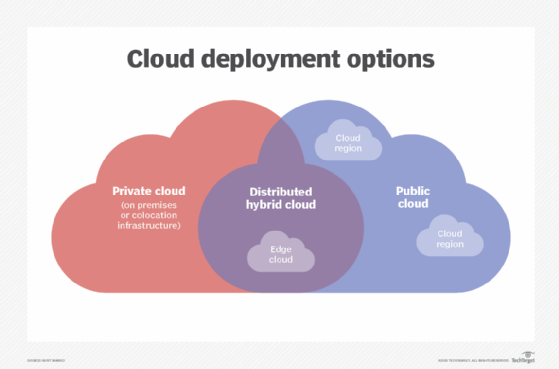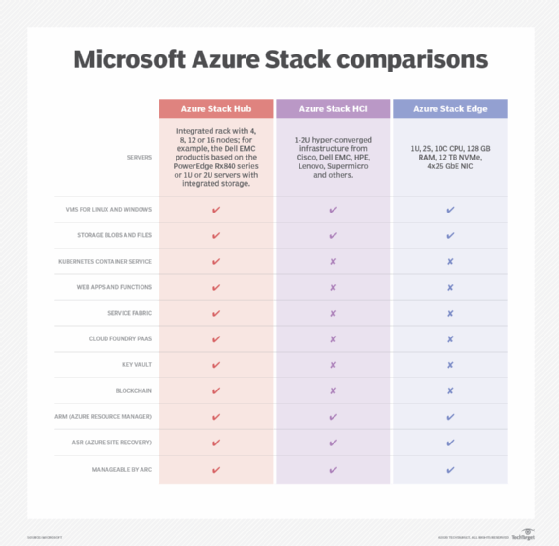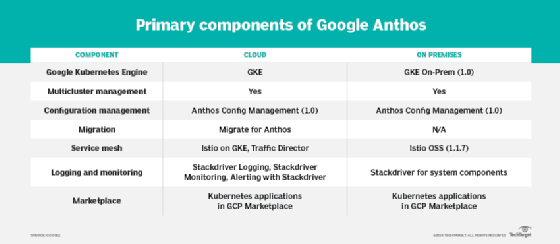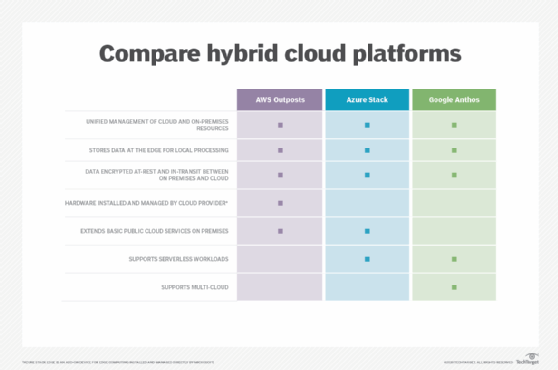
everythingpossible - Fotolia
Hybrid cloud infrastructure design for AWS, Azure, Google Anthos
Learn about infrastructure for tightly coupled hybrid clouds and delivering AWS Outposts, Microsoft Azure Stack and Google Anthos from an on-premises data center.
AWS Outposts, Microsoft Azure Stack and Google Anthos have set the standard for what organizations can expect from hybrid cloud computing, with each having unique hybrid cloud infrastructure design characteristics to bridge the gap between the on-premises data center and the cloud. It hasn't always been that way, however.
The term hybrid cloud has been shrouded in confusion and ambiguity since the concept emerged as a way for cloud-leery enterprises to ease their way into cloud computing. Initially, the industry used the term to describe implementations using two sets of cloud services, each with distinct service descriptions, software stacks, APIs and management consoles -- one on private infrastructure and self-managed, the other comprised of public cloud services. Loosely coupled, these two "clouds" lacked the ability to seamlessly and autonomously share workloads and data between the two environments. Such dual-cloud implementations were "hybrid" in the same way a vehicle made by welding together an electric golf cart and a VW Beetle is a hybrid car.
The limitations of rudimentary hybrid implementations quickly became apparent. This led infrastructure software vendors and cloud operators to develop unified systems that span public and private infrastructure. Variously called true hybrid cloud or distributed cloud, this evolutionary hybrid cloud has consistent service definitions and APIs, with a unified management control plane that can span public cloud infrastructure, private data centers, private hardware in colocation facilities and edge locations like remote offices or manufacturing sites.
Not a form of edge computing
Some characterize the new generation of distributed cloud services as a form of edge computing. The edge, however, is more accurately seen as a subset of broader private cloud implementations and use cases. Gartner senior analyst Santhosh Rao put it well: "Cloud computing and edge are complementary, rather than competitive or mutually exclusive. Organizations that use them together will benefit from the synergies of solutions that maximize the benefits of both centralized and decentralized models."
Such tightly coupled, distributed clouds deliver on the ethos Microsoft espoused when it introduced Azure Stack more than four years ago (emphasis added):
Enterprises have to approach cloud as a model -- not a place. This model cuts across infrastructure, applications and people, and requires a hybrid cloud approach that provides consistency across private, hosted, and public clouds.

Gartner calls this model distributed cloud but frames it somewhat differently: it's an extension of location-independent public cloud services to locations specified by the customer in facilities and on hardware under the control of their IT organization or its proxy (i.e., a service provider). Such distributed cloud implementations resemble today's distributed electric grid, in which massive central facilities owned by a utility and supplemented by local generation provide baseline capacity from rooftop solar panels or diesel generators.
As Gartner sees them, these hyper-local cloud implementations -- as exemplified by AWS Outposts, Azure Stack and Google Cloud Anthos -- are an extension of the traditional concept of cloud regions and availability zones. Furthermore, the analyst firm expects most cloud platforms will offer distributed cloud services by 2024, which is, in all likelihood, far too conservative a timeline.
Since introducing Azure Stack in early 2016, Microsoft has spent the intervening years expanding its capabilities, lining up hardware partners and extending the model to small appliances designed for edge implementations. AWS announced a similar product, AWS Outposts, at re:Invent 2018, delivering the first Outposts models a year later. Google Cloud, the last to release a distributed cloud platform, Cloud Anthos, based its offering on the Google Kubernetes Engine (GKE) service and, like Microsoft, uses hardware partners to provide data center and edge systems.
All three -- AWS Outposts, Microsoft Azure Stack and Google Cloud Anthos -- provide a uniform set of cloud services, APIs and management interfaces across public and private infrastructure. There are significant differences in implementation and capabilities for each of these hybrid cloud infrastructure design options, however.
AWS Outposts
Although AWS can be opinionated about the public cloud service model, like its parent, the cloud giant listens to its customers and isn't afraid to change course. Despite some historical skepticism about hybrid implementations, AWS developed a product that delivers the ultimate in-service integration and consistency in Outposts. AWS Outposts effectively act as remote AWS regions running on hardware managed by AWS and deployed on premises with resources dedicated to a particular customer.
Outposts' microregions run on systems installed, operated and monitored by AWS using the same server and storage hardware as in its hyperscale data centers, with resources provided, deployed and managed via the AWS Management Console. To users and cloud administrators, an Outpost looks like a private AWS region that offers a subset of standard AWS services.
As of late 2020, Outposts supported the following:
- Elastic Compute Cloud (EC2) instances including:
- General purpose (M5/M5d)
- Compute optimized (C5/C5d)
- Memory optimized (R5/R5d)
- Graphics optimized (G4dn)
- I/O optimized (I3en)
- Virtual Private Cloud support with multiple subnets and a local gateway for network address translation.
- Available uplinks are 1-8 1 Gbps, 1-16 10 Gbps, 1-4 40 Gbps, or 1-4 100 Gbps.
- Elastic Block Store General Purpose SSD (gp2) volumes in tiers from 2.7 to 55 TB.
- S3 storage coming soon.
- Container clusters:
- Amazon Elastic Container Service (ECS) clusters -- Amazon container management.
- Amazon ECS for Kubernetes -- Kubernetes container management.
- Amazon Elastic MapReduce
- Amazon Relational Database Service MySQL and PostgreSQL instances (other database engines to be added).
- App Mesh Envoy proxy.
- Management services including EC2 AWS Auto Scaling groups, CloudFormation, CloudWatch, CloudTrail and Elastic Beanstalk.
(See documentation for the latest list of supported Amazon services.)
Outposts' hardware mounts in a standard 42U rack with redundant power distribution units, a central power bus bar and two external power inputs. It requires five, 10 or 15 kVA single- or three-phase power depending on the rack capacity.
Microsoft Azure Stack
Being the original, tightly integrated, hybrid cloud has given Azure Stack time to mature and evolve into the broadest portfolio of distributed cloud products spanning multiple scenarios, namely:
- Azure Stack Hub for data centers via rack-scale systems of four to 16 nodes. Azure Stack Hub is the original Azure Stack implementation and physically similar to Outposts. Unlike Outposts, however, Azure Stack Hub customers can own and operate the equipment or it can be leased and managed by a third-party service provider.
- Azure Stack HCI for SMB data centers and large enterprise branch offices using clusters of hyper-converged systems with 2-16 nodes.
- Azure Stack Edge for smaller, edge locations and IoT applications using single-node 1U rackmount or ruggedized hardware.
The following table summarizes each product's key specifications and features.

Azure Arc is Microsoft's new, still-in-preview product providing a single management interface for all public Azure and distributed Azure Stack resources. Arc initially supports VMs, Kubernetes clusters and databases, but expect the feature list to expand before the product is generally released.
Google Cloud Anthos
With Anthos, Google Cloud mirrors Microsoft's software-centric approach to distributed cloud services by partnering with vendors like Cisco, Dell EMC, HPE, Lenovo and Nutanix to build compatible hardware, typically using hyper-converged infrastructure or compact 1-2U servers. For example, Dell EMC has qualified the PowerFlex family of appliance or converged systems.
Anthos takes a container-centric approach to hybrid cloud, however, and provides the following services that can span Google Cloud and private infrastructure:
- GKE for Google Cloud or on premises
- Multi-cluster management
- Anthos Config Management, Policy Controller and Config Connector
- Migrate for Anthos (workload migration)
- Anthos Service Mesh, Service Mesh dashboards, MeshCA certificate authority
- Cloud Run for Anthos (serverless functions)
- Cloud Logging and Cloud Monitoring for system components
- Binary Authorization
Like the AWS Management Console for Outposts and ARM or Azure Arc for Azure Stack, Anthos provides a unified management stack for container-based infrastructure and workloads. GKE is the foundation of on-premises Anthos implementations and requires an administration cluster to manage the infrastructure and one or more user clusters for workloads.
Currently, GKE requires VMware vSphere 6.5 or 6.7 to host nodes, storage and virtual networks. The default hardware configuration for both administration and user nodes is four CPUs, 8 GB RAM and 40 GB storage, with a small percentage of CPU and memory reserved for Kubernetes overhead.

Hybrid cloud infrastructure design options
We've focused on Outposts, Azure and Google Cloud because these are the most popular services with enterprises.
However, organizations primarily interested in using public cloud infrastructure as an extension of traditional VM infrastructure can get the same tightly integrated system via VMware Cloud on AWS.
The service provides VMware's software-defined data center virtualized infrastructure and can be managed by the same VMware software, whether vCenter Server or the vRealize Suite, used for on-premises systems.
The distributed hybrid cloud platforms outlined here provide a way to extend services from one of the three major cloud providers to private data centers or branch locations. The significance and adoption of these hybrid cloud infrastructures will increase as organizations embrace edge computing and need to extend cloud services outside of hyperscale or enterprise data centers.
Which hybrid cloud enterprises choose should depend on a number of factors, however, including, but not limited to, their cloud provider preference. Enterprises must also consider hybrid cloud infrastructure design factors and how that architecture is implemented, as well as the overall capabilities.

All these features can differ significantly among providers, as illustrated here by the big three hybrid cloud platforms -- AWS Outposts, Microsoft Azure Stack and Google Cloud Anthos.







